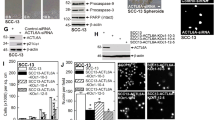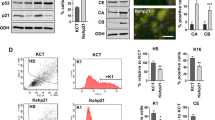Abstract
Cyclin-dependent kinase inhibitor p27kip1 (p27) has recently been implicated as a positive regulator of cellular motility and is a marker of poor prognosis in several forms of cancer when localized to the cytoplasm. Cytoplasmic p27 exerts its effect on migration by binding to and inhibiting the activation of the small GTPase and cytoskeletal organizer RhoA, consequentially loosening cell substrate grip and enhancing movement. Using DNA damage as a p27 nuclear import signal, we found that the E7 oncoprotein from human papillomavirus type 16 (HPV-16), the etiological agent of cervical cancer, enhanced both the cytoplasmic retention of p27 and the migration of human foreskin keratinocytes (HFKs) in a phosphoinositide-3 kinase (PI3K)/Akt-dependent manner using a standard wound assay. Increased migration in E7-expressing HFKs correlated with an Akt-regulated downregulation of RhoA activity through p27 binding under conditions where a p27 nuclear import signal is given (that is, DNA damage). Under these conditions, inhibition of the downstream RhoA effector ROCK enhanced control cell migration, whereas relatively unaffecting E7-expressing cells, further implicating that the inhibitory effect of E7 on RhoA positively regulates migration. We believe that the E7 protein from HPV-16 can modulate the cytoplasmic localization of p27 and may in turn regulate tumor metastasis/aggressiveness through the PI3K/Akt pathway.
This is a preview of subscription content, access via your institution
Access options
Subscribe to this journal
Receive 50 print issues and online access
$259.00 per year
only $5.18 per issue
Buy this article
- Purchase on Springer Link
- Instant access to full article PDF
Prices may be subject to local taxes which are calculated during checkout




Similar content being viewed by others
References
Baseman JG, Koutsky LA . (2005). The epidemiology of human papillomavirus infections. J Clin Virol 32: S16–S24.
Besson A, Gurian-West M, Schmidt A, Hall A, Roberts JM . (2004). p27Kip1 modulates cell migration through the regulation of RhoA activation. Genes Dev 18: 862–876.
Dellas A, Schultheiss E, Leivas MR, Moch H, Torhorst J . (1998). Association of p27Kip1, cyclin E and c-myc expression with progression and prognosis in HPV-positive cervical neoplasms. Anticancer Res 18: 3991–3998.
Doorbar J . (2006). Molecular biology of human papillomavirus infection and cervical cancer. Clin Sci (Lond) 110: 525–541.
Fiedler M, Muller-Holzner E, Viertler HP, Widschwendter A, Laich A, Pfister G et al. (2004). High level HPV-16 E7 oncoprotein expression correlates with reduced pRb-levels in cervical biopsies. FASEB J 18: 1120–1122.
Hudelist G, Manavi M, Pischinger KI, Watkins-Riedel T, Singer CF, Kubista E et al. (2004). Physical state and expression of HPV DNA in benign and dysplastic cervical tissue: Different levels of viral integration are correlated with lesion grade. Gynecol Oncol 92: 873–880.
Incassati A, Patel D, McCance DJ . (2006). Induction of tetraploidy through loss of p53 and upregulation of Plk1 by human papillomavirus type-16 E6. Oncogene 25: 2444–2451.
Li R, Wheeler TM, Dai H, Sayeeduddin M, Scardino PT, Frolov A et al. (2006). Biological correlates of p27 compartmental expression in prostate cancer. J Urol 175: 528–532.
McAllister SS, Becker-Hapak M, Pintucci G, Pagano M, Dowdy SF . (2003). Novel p27(kip1) C-terminal scatter domain mediates rac-dependent cell migration independent of cell cycle arrest functions. Mol Cell Biol 23: 216–228.
Menges CW, Baglia LA, Lapont R, McCance DJ . (2006). Human papillomavirus type 16 E7 upregulates akt activity through the retinoblastoma protein. Cancer Research 66: 5555–5559.
Motti ML, Califano D, Troncone G, De Marco C, Migliaccio I, Palmieri E et al. (2005). Complex regulation of the cyclin-dependent kinase inhibitor p27kip1 in thyroid cancer cells by the PI3K/AKT pathway: regulation of p27kip1 expression and localization. Am J Pathol 166: 737–749.
Nobes CD, Hall A . (1999). Rho GTPases control polarity, protrusion, and adhesion during cell movement. J Cell Biol 144: 1235–1244.
Shin I, Yakes FM, Rojo F, Shin NY, Bakin AV, Baselga J et al. (2002). PKB/Akt mediates cell-cycle progression by phosphorylation of p27(Kip1) at threonine 157 and modulation of its cellular localization. Nat Med 8: 1145–1152.
Shiozawa T, Shiohara S, Kanai M, Konishi I, Fujii S, Nikaido T . (2001). Expression of the cell cycle regulator p27(Kip1) in normal squamous epithelium, cervical intraepithelial neoplasia, and invasive squamous cell carcinoma of the uterine cervix. immunohistochemistry and functional aspects of p27(Kip1). Cancer 92: 3005–3011.
Vasko V, Saji M, Hardy E, Kruhlak M, Larin A, Savchenko V et al. (2004). Akt activation and localisation correlate with tumour invasion and oncogene expression in thyroid cancer. J Med Genet 41: 161–170.
Walboomers JM, Jacobs MV, Manos MM, Bosch FX, Kummer JA, Shah KV et al. (1999). Human papillomavirus is a necessary cause of invasive cervical cancer worldwide. J Pathol 189: 12–19.
Watanabe J, Sato H, Kanai T, Kamata Y, Jobo T, Hata H et al. (2002). Paradoxical expression of cell cycle inhibitor p27 in endometrioid adenocarcinoma of the uterine corpus – correlation with proliferation and clinicopathological parameters. Br J Cancer 87: 81–85.
Westbrook TF, Nguyen DX, Thrash BR, McCance DJ . (2002). E7 abolishes raf-induced arrest via mislocalization of p21(Cip1). Mol Cell Biol 22: 7041–7052.
Wu FY, Wang SE, Sanders ME, Shin I, Rojo F, Baselga J et al. (2006a). Reduction of cytosolic p27(Kip1) inhibits cancer cell motility, survival, and tumorigenicity. Cancer Res 66: 2162–2172.
Wu S, Meng L, Wang S, Wang W, Xi L, Tian X et al. (2006b). Reversal of the malignant phenotype of cervical cancer CaSki cells through adeno-associated virus-mediated delivery of HPV16 E7 antisense RNA. Clin Cancer Res 12: 2032–2037.
Acknowledgements
We thank Craig Menges, Daksha Patel and Barry Thrash for critical review of this paper, Dirk Bohmann for the use of reagents and lab space, and Brian Ward for assistance with microscopy. National Institute of Allergy and Infectious Diseases Grant AI030798 (to DJ McCance). This publication was also made possible by Grant Number GM068411 from the Institutional Ruth L Kirschstein National Research Service Award and its views are the sole responsibility of the authors and not of the NIH.
Author information
Authors and Affiliations
Corresponding author
Additional information
Supplementary Information accompanies the paper on the Oncogene website (http://www.nature.com/onc).
Supplementary information
Rights and permissions
About this article
Cite this article
Charette, S., McCance, D. The E7 protein from human papillomavirus type 16 enhances keratinocyte migration in an Akt-dependent manner. Oncogene 26, 7386–7390 (2007). https://doi.org/10.1038/sj.onc.1210541
Received:
Revised:
Accepted:
Published:
Issue Date:
DOI: https://doi.org/10.1038/sj.onc.1210541
Keywords
This article is cited by
-
HPV E7-mediated NCAPH ectopic expression regulates the carcinogenesis of cervical carcinoma via PI3K/AKT/SGK pathway
Cell Death & Disease (2020)
-
Bacteria-mediated delivery of RNAi effector molecules against viral HPV16-E7 eradicates oral squamous carcinoma cells (OSCC) via apoptosis
Cancer Gene Therapy (2019)
-
Conditional reprogramming and long-term expansion of normal and tumor cells from human biospecimens
Nature Protocols (2017)
-
The role of the PI3K/Akt/mTOR signalling pathway in human cancers induced by infection with human papillomaviruses
Molecular Cancer (2015)
-
PI3K/AKT pathway-mediated regulation of p27Kip1 is associated with cell cycle arrest and apoptosis in cervical cancer
Cellular Oncology (2015)



